|
|
ARTHROPODS:
Insects»
Spiders»
Centipedes»
Millipedes»
Sowbugs»
Harvestmen»
Mites
& Ticks»
Scorpions»
Identification
Tips»
About
the Critter Files»
Links» |
|
|
|
 |
DAMSEL
BUGS
Critter
Files/Insects/True
Bugs/Damsel Bugs
By Blake Newton
University of Kentucky Department of Entomology |
| |
|
| Common
Kentucky Damsel Bugs: |
| |
| TAXONOMY |
KINGDOM:
Animalia | PHYLUM: Arthropoda | CLASS: Insecta | ORDER: Hemiptera
| FAMILY: Nabidae (damsel bugs) |
| |
| Other
Names: Nabids |
| |
WHAT
IS A DAMSEL BUG?
LIFE CYCLE
ECOLOGY
PEST STATUS
COMMON KENTUCKY DASMEL BUGS
COLLECTING & PHOTOGRAPHY
DAMSEL BUG FACTS
MYTHS, LEGENDS, AND FOLKLORE |
| |
| WHAT
IS A DAMSEL BUG? |
|
Damsel
Bugs (often called "nabids," from the family name Nabidae)
are in the order Hemiptera which also includes assassin
bugs, stink bugs, plant
bugs, and many other insects. All insects in Hemiptera
share a few characteristics, including piercing and sucking mouthparts,
and wings which are membranous and clear at the tips, but hardened
at the base.
Damsel bugs resemble
a cross between a stink bug and a praying mantid. Like stink
bugs, damsel bugs have a somewhat flat, five-sided shape. Like
mantids, damsel bugs have spiny "raptorial" front legs
used to grab prey. Most damsel bugs in Kentucky are about
1 cm long and are tan or gray in color. |
| |
 Damsel
Bug, Nabis sp., showing raptorial front legs
Damsel
Bug, Nabis sp., showing raptorial front legs
(R. Bessin, 2001) |
|
| SIZE:
Body length up to 3/8" long |
| |
| LIFE
CYCLE |
|
Like
all Hemiptera, damsel bugs go through a simple metamorphosis with
egg, nymph, and adult stages. During warm months, female damsel
bugs insert eggs into the stems of low-growing plants. The
eggs hatch soon afterward. Damsel bug nymphs look like small,
wingless versions of the adults. As they grow, the nymphs
molt (shed their skins) several times before turning into full-grown
adults. Most damsel bugs spend the winter as adults or large
nymphs.
|
| ECOLOGY |
|
| |
Damsel
bugs are predators that live on low-growing plants where they capture
and eat aphids, caterpillars, and other insects. In Kentucky,
damsel bugs are especially common in agricultural habitats, such
as soybean, corn, and alfalfa, where they feed on many pest species.
Although damsel bugs are predators, they are sometimes prey
for spiders, assassin bugs, birds, and other creatures. |
| |
| PEST
STATUS |
|
Damsel
bugs are not pests, and are believed to be beneficial insects. They
are known to feed on several economically important pests, including
caterpillars like the corn earworm, soybean looper, and green cloverworm.
However, damsel bugs also feed on other predators, like assassin
bugs, minute pirate bugs, and big-eyed bugs. In fact, all
of these predators feed on one another, a phenomenon called "intraguild
predation" by scientists. |
| |
| |
| COMMON
KENTUCKY DAMSEL BUGS |
|
|
DAMSEL
BUGS, NABIS spp.
GENUS: Nabis
The most commonly encountered
damsel bugs in Kentucky are in the Nabis genus, most of
which are tan in color and 3/8" long when fully grown. Nabis
americoferus and Nabis roseipennis are particularly
common in clover, soybeans, and alfalfa. Damsel bugs in the
Nabis genus are also found in fence rows, gardens, and
other habitats with low-growing, sunlit vegetation. |
|
|
|
 Damsel
Bugs in the Nabis genus (R. Bessin, 2001)
Damsel
Bugs in the Nabis genus (R. Bessin, 2001) |
|
| |
| COLLECTING
& PHOTOGRAPHY |
|
Although damsel bugs
are fairly common, they are sometimes difficult to find. Damsel
bugs tend to stay low to the ground, often hidden within thick vegetation.
With patience, damsel bugs can usually be found if a patch
of alfalfa or clover is closely examined on a warm summer day. Damsel
bugs can almost always be captured in a sweep net when used on a
hot day in alfalfa, clover, or soybean.
Although damsel bugs
are able to fly, and can run quickly at times, they will usually
remain still long enough to snap a picture as long as they are not
disturbed, especially on a summer morning before the heat of the
day arrives. If you get lucky, you may find one catching and
eating prey. |
| |
| DAMSEL
BUG FACTS |
|
"Damsel bug"
may not seem like a good name for a predatory insect. Damsel
bugs are so-called because they hold their front legs up, almost
as though they were lifting a skirt hem for a spin around the dance
floor.
Although many damsel
bugs resemble the ones shown on this page, some closely resemble
ants, such as this
one pictured at the Garden Safari website.
|
| |
| MYTHS
- LEGENDS - FOLKLORE |
|
| Do you know any myths,
legends, or folklore about damsel bugs? Let us know if you do!
|
|
Original document: 25 May 2004
Last updated: 25 May 2004
Photos courtesy R. Bessin and B. Newton, University of Kentucky
The Kentucky Critter
Files are maintained by Blake Newton, Department of Entomology, University
of Kentucky.
Contact: blaken@uky.edu |
|

